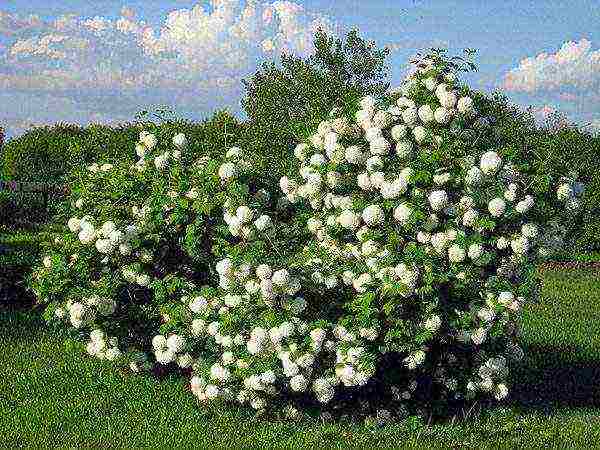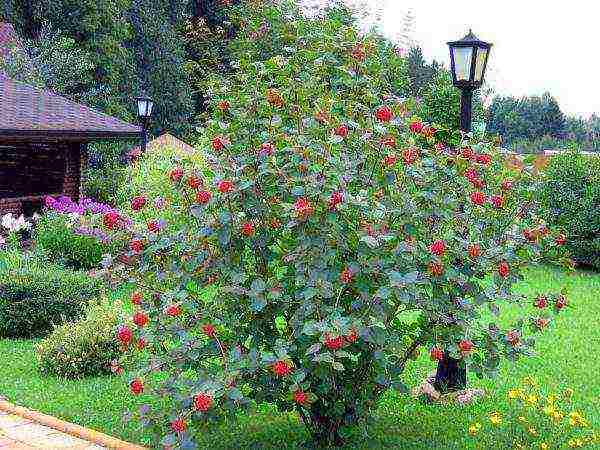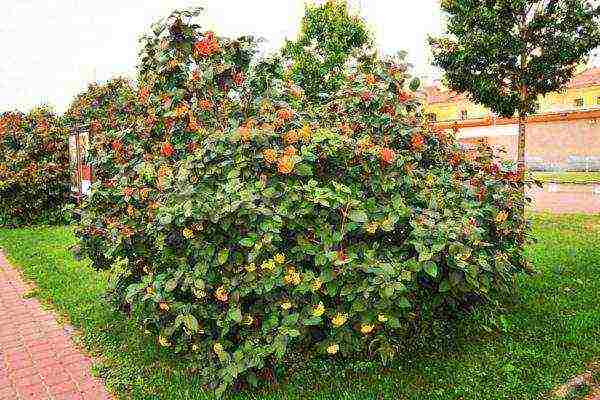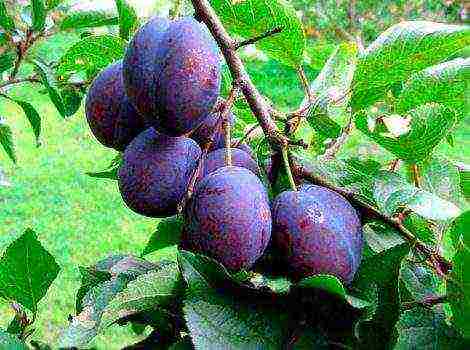Content
Rules for planting and caring for viburnum
The beautiful viburnum can be found more and more often in gardens, in summer cottages and on city streets. The plant is unpretentious, does not require special care. In addition to decorative qualities, viburnum has many medicinal properties.
Features of planting viburnum in the fall
Planting and caring for the plant does not require special difficulties and difficulties. Viburnum grows well on neutral and weak acidity soils (pH 5.5-6.5). Sand, peat and podzolic soil are not suitable. The depth of the ground is at least one meter.
Kalina prefers that the site of its location is well lit, but it grows well in shady places. According to some experts, viburnum in the shade attracts pests less.
Viburnum is planted both in the spring, when the leaves did not appear, and in the fall, when the leaves have already fallen off. Before planting, the land is dug up and freed from weeds. Fertile soil does not need organic fertilization. Fertilize poor soil just before planting.
Before planting, a recess with a diameter of 60 cm and a depth of half a meter is dug. The distance between the pits should be at least one and a half meters. The soil from the hole is mixed with organic and mineral fertilizers. One recess requires:
- humus or peat (10 l);
- potassium sulfate (1/2 cup);
- superphosphate (1 glass);
- dolomite flour (1 glass);
- urea (2 tbsp. l.)
Everything is thoroughly mixed and poured 2/3 into the recess. Then the soil mixture is poured with 3-4 buckets of water. For 6-7 days, the fossa is moistened. During planting, the remaining mixture is poured into the hole so that a tubercle appears, the height of which should be 10-12 cm. A seedling is placed on the tubercle in an upright position, sprinkled with soil and compacted. Then a hole is made in the near-trunk circle and watering is performed.
Mulching is carried out in late spring when the soil is warm and moist. Mulch in the form of crushed tree bark, wood chips or peat is scattered around the bush.

Benefits of autumn planting and transplanting in open ground
It is known that viburnum can be planted both in spring (late April - early May) and in autumn (September). According to experienced gardeners, planting a plant in the fall has some advantages:
- planting is best done in early September, so that the seedlings have time to take root;
- in the fall, the soil around the plant will settle, become dense;
- there is no intense heat in the autumn period, therefore, there is no need for frequent watering;
- a seedling planted in the fall, vegetates in the spring, as the roots develop, and the bud is sleeping at this time, thanks to this, young shoots develop more actively;
- in the spring there are many things to do in the garden and garden, so in the fall, when there is more free time, you can start planting viburnum.
Care: how to plant and prune bushes?
You need to take care of the viburnum as well as for other cultivated plants: weed control, regular watering, loosening the soil in the near-trunk circle, mulching, cutting and forming the crown, fighting diseases and pests.

Watering
Watering is carried out in the evening, shedding the soil by 40 cm. Adult bushes should be watered during the growing season and when the berries are ripe.
Top dressing
Usually, dressings are made dry, in hot dry weather it is better to dissolve them in water. You need to feed the plant several times:
- In early spring, when young leaves bloom. Urea is introduced (2 tbsp. L.);
- Fertilizer is applied just before flowering. Wood ash (1/2 liter) or potassium sulfate (2 tbsp. L) should be scattered;
- Feeding is carried out after flowering. Nitrophoska or nitroammofoska is introduced (2 tbsp. L.).
- Liquid dressing is applied in October, when the crop has already been harvested. Potassium sulfate (2 tablespoons) and superphosphate (3 tablespoons) are added to ten liters of water. Each viburnum bush requires two buckets of fertilizer
Reproduction and cultivation
Viburnum can be propagated by dividing the bush, seeds, cuttings and layering. After reproduction, shoots can be transplanted into open ground.
Reproduction by dividing the bush
Usually this method is used if the species of viburnum is valuable and needs to be preserved or transplanted to another place. The plant is divided into several parts. At least 3 buds remain on each part. Separation and transplanting is done in spring or autumn.

Propagation by cuttings
In June or early July, when the branches are flexible, harvesting of cuttings begins. When cutting, it is necessary to monitor the number of nodes, there should be at least three of them. The length of the planting material is about 10 cm. An oblique cut runs along the bottom of the cutting, the leaves are cut off. It is advisable to hold the material with drugs to accelerate growth (Kornevin). Then place the cuttings in a greenhouse, deepening 2 cm into the ground. The soil mixture is prepared from the same parts of sand and peat. When rooting, the greenhouse is covered with plastic wrap or glass.
Cuttings require constant watering. Before winter, rooted sprouts are insulated. Sawdust, roofing felt, peat are used as a covering material. In the spring, the planting material is planted for permanent residence.
How to propagate by layering?
Grooves break out near the viburnum bush in spring. Young shoots are leaning from the bush and covered with soil and fixed with wire. The tip should remain on the surface. Slightly above the filled soil, an incision is made on the shoot. By autumn, the layers will give roots, young shoots will appear on the buds. The shoots are separated from the adult plant and transplanted to a new location.
Seed propagation is not encouraged by gardeners, since a long period of time passes before germination. The technology is somewhat more complex. How you see, viburnum can multiply in a variety of ways
Pruning
You can prune the plant both in autumn and early spring. Kalina definitely needs sanitary and rejuvenating pruning. In addition, pruning forms the volume of the plant. Pruning in early spring each year limits the size of the shrub and increases the light in the crown. Weak diseased branches are also removed.
Next, the old 7-9-year-old branches are cut out, which have already borne fruit. Leave only strong, annuals. Low flowering bushes are cut completely. Stumps remain, protruding 15-20 cm above the ground. Sleeping buds give young shoots and viburnum very soon recovers.
When the bush is not cut for a long time, it thickens, loses its beauty.Rejuvenating pruning is done after the kidneys have awakened. Old branches are cut or cut with pruning shears, small hemp five centimeters long remain. Young shoots appear from the stumps. Over the summer, weak branches are removed on the shoots.

Formation
Unlike other fruit shrubs, viburnum does not require frequent pruning of shoots. Shoots are usually removed once a year.
When a plant is formed by a bush, in the spring all branches are removed by 2-3 nodes. Growth points are pinched when they reach a length of 30 cm. Awakened buds will give young shoots. They will be the main component of the plant. IN in subsequent years, systematic pruning of the viburnum will form the desired size of the bush.
If you want to see the viburnum as a tree, at the beginning of the formation you need to leave the vertical central trunk. The rest of the side branches should be removed. Shoots around the bush are also cut off. After 2-3 years, a trunk with a height of about two meters will form. The crown is formed by pinching the growth point. The tip of the guidewire is cut off and several buds appear at the cut site. Thanks to this procedure, the tree becomes branched.
It is not difficult to grow viburnum on your own site. You need to be able to competently take care of her. Then the plant will delight you with magnificent flowers and beautiful healthy berries.


